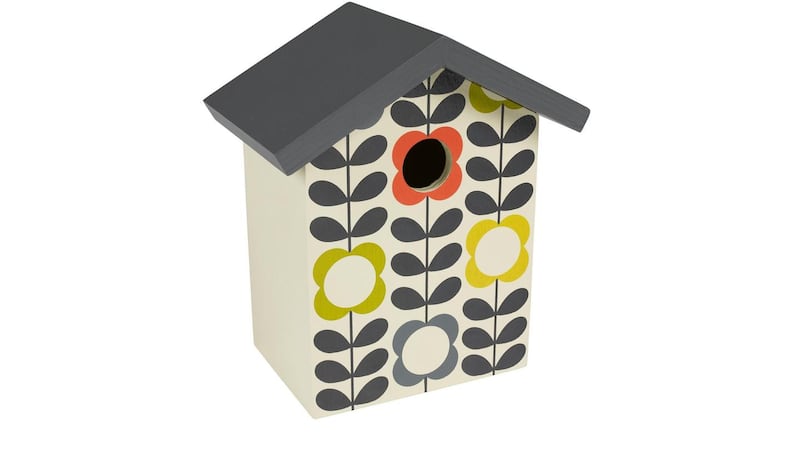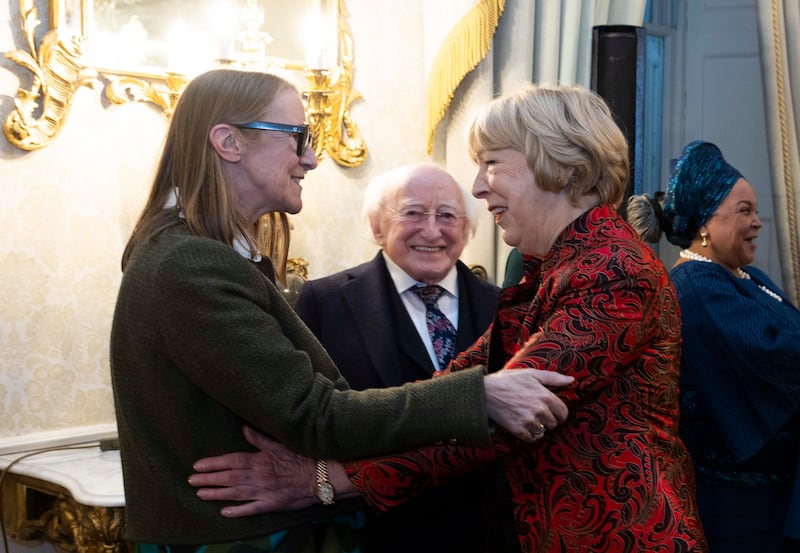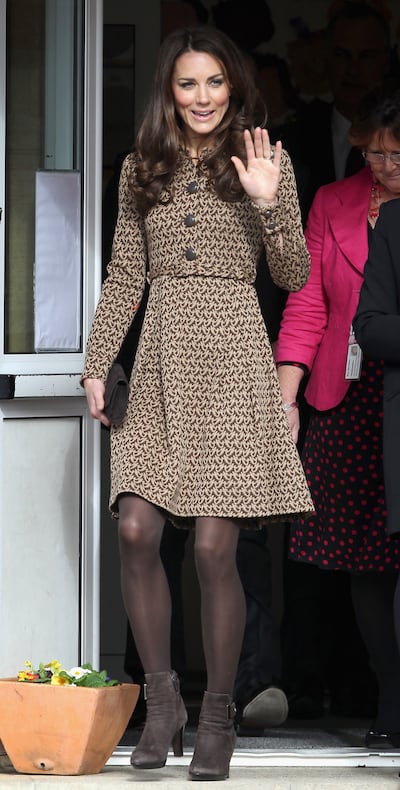Repetition is key when it comes to understanding the rise and fall and rise again of Orla Kiely. The constant for the Dublin designer has always been repeating patterns. It’s simply how her mind works.
Take this quote from Kiely from 2018, a pivotal year for her company, when a retrospective of her life’s work was displayed in London, where the designer has been based for three decades. Back then she said: “I sometimes think that my brain works in repeat. I love the order and regiment of repetition ... pattern is not a trend for me, to be taken up one minute and abandoned the next when the winds of fashion change. Pattern is in me. It is my life.”
The best example of this mission statement is her simplest, most immediately identifiable motif: the rounded rowan leaves in her famous and patented Stem pattern. That’s the print you see decorating bags, mugs, kitchen containers, bed linen and rugs, those comforting, joy-bringing leaves repeating and repeating in the designer’s favourite colours: yellows, olives, oranges, greens, browns and reds. Even the least design-conscious person is almost certain to know this pattern. The same exhibition, Orla Kiely: A Life in Pattern is now being displayed in Kilkenny’s National Craft & Design Gallery. There will be a wall of handbags, giant dresses hanging from the ceiling and a vast print library showing the evolution of Orla Kiely over the decades.

Cosmetics pioneer Elizabeth Arden said it best: “Repetition makes reputation, and reputation makes customers.” Kiely, who grew up in Shankill, Dublin, in the 1960s and 1970s in a home with a green formica kitchen with an orange ceiling – “those colours stayed with me” – has always understood the importance of constancy. It meant that loyal customers who loved her distinctive aesthetic – retro with a twist – stayed with the designer, even through the worst times.
READ MORE
Repetition makes reputation but one thing Kiely and her husband and business partner Dermott Rowan are in no rush to repeat is the failure of the retail and online business in 2018. We’ll come to that later. First, to the reason Kiely is back in Dublin, in the grand Wellington Room of the Merrion Hotel, with her sister Nessa and a PR adviser and an Irish Times photographer. It was a happy coincidence that, as she prepared to open the exhibition, she was also being presented with a Presidential Distinguished Service Award for the Irish Abroad by Michael D Higgins for her “profound contribution to the lives of others” as a member of the diaspora. The ceremony happened the night before in the Áras. Kiely excitedly shows off photographs of her mother and the president deep in conversation – it turned out he had a Galway connection to a member of her family.

That she is in Dublin to receive an award from the President only days before the exhibition opens is pure serendipity. “It wasn’t planned,” she says. “It’s lovely to bring the exhibition here, because although I’m in London I still feel 100 per cent Irish ... and when you travel, you feel this pride in your Irishness.” She is head to toe in her own creations, standing tall in a vintage Orla Kiely cardigan and a bespoke green patterned dress she decided was appropriate for meeting the President. Her hair is slicked back in a ponytail, her signature look. She wears statement glasses, comfy black runners and an elegant white shirt, which once belonged to her mother. Her parents, Bob and Maeve Kiely, were the original owners of Kiely’s pub in Donnybrook. Bob died in March 2023, while Maeve, a former science graduate and pharmacist forced to give up her career when she married, a woman who always encouraged her daughters to forge strong careers, was in the Áras to see her daughter honoured. Her sister Nuala couldn’t make the event but her only brother, Billy, a simultaneous interpreter based in Paris, was on hand to translate for some of the other international award winners. It was a proud family affair. And after their exciting night in the Phoenix Park, her youngest sister, Nessa, is sitting in on the interview. “I’ll be more comfortable with Nessa here,” says Kiely.
According to well-ventilated Kiely family lore, her Galway granny, who would drive to Dublin in a Mini Cooper with various crochet and rug tufting projects, was a crafty inspiration as a child, while Orla’s father insisted on buying his budding young designer daughter a “proper” sewing machine at the age of 12. Kiely sewed Nessa’s cool-sounding 1970s Confirmation suit – a corduroy bomber jacket with cross-body hessian bag. She took early and lifelong inspiration from the colours in the nearby Wicklow countryside and from Mother Peter, her “quirky and brilliant” art teacher at school in Loreto, Foxrock. One of her first jobs in fashion was assisting friend and mentor designer Paul Costelloe in designing a uniform for An Post staff. After graduating from the National College of Art and Design with a degree in textile design she went to New York, mixing paint colours for a wallpaper designer. “It was an amazing time, I learnt so much about colour, I learnt things I still use today”.
Kiely went on to design patterns for Esprit while studying for a master’s in knitwear at the Royal College of Art in London. She remembers, fondly, the hats she designed, her first success story. They were bought by Harrods. It was around this time that her father famously deduced, while at one of Kiely’s trade shows in London, that while it was difficult to spot hat-wearing women at the event, nearly every woman was carrying a handbag. Kiely quickly made the swerve to handbags, creating them at night and on weekends while working at Marks & Spencer. It was some Japanese partners who early on suggested she make the Stem pattern synonymous with the Orla Kiely brand. “They thought it could become our Burberry check,” she remembers. And very quickly, that’s exactly what happened.
She met Rowan in Dublin, through mutual friends. He was a financial controller in the construction industry. The relationship was on and off for a while but they eventually married in 1993, working together to build Kiely’s brand from the kitchen table in their London flat and studio while she nursed their first child. “I always think of the company as being the same age as my eldest, Robert,” she says, smiling.

How do they navigate company business as a married couple, Rowan with his finance background, and Kiely the visually minded creative? “I’m the perfectionist, who wants everything to be nice,” she says. “I need time and consideration. I’m fussy. I was the one making sure everything is good, worthy of the name [Orla Kiely]. I’m not saying Dermott wasn’t like that, but he was definitely more about business. He had the bigger picture. He always wanted the bigger business; I was always happy with the organic thing. I think we ended up in the middle and it kind of worked.” She points out that many of her contemporaries, designers she started off with in the 1990s, are no longer still in business. “So we’ve survived, with ups and downs, but we are still here as a brand. And people still enjoy it and like it.
“I think we ended up with a good balance,” she says of their working dynamic. “I needed to be pulled and pushed a bit.”
Pulling and pushing. Ups and downs. Kiely has not spoken much in the past seven years about the financial storm that hit Kiely Rowan plc in September 2018, when the company made the shock announcement that its retail and online business would cease trading. At the time both she and the company appeared to be flying high. Her designs were everywhere – on the back of buses, on a range of Citroën cars and on prominent clothes horses such as Alexa Chung and Kate Middleton who in 2012 was photographed wearing Kiely’s Little Bird dress causing the company’s website to crash.
The turnover for the UK business, reported in March 2017, was about €9 million. The pinnacle of the brand’s global expansion: a stunningly beautiful, architect designed, flagship store in a 19th-century manufacturing building in Soho, New York. In London there were other equally stylish shops in tourist-mobbed Covent Garden and on fashionable King’s Road. You could visit Orla Kiely stores in Seoul and Tokyo, all decked out in that nostalgic mid-century modern aesthetic beloved of the designer. In Ireland, she was stocked in countless outlets such as Kilkenny Design. A stand-alone Orla Kiely boutique had opened the previous year in Kildare Village.

Meanwhile, Kiely’s reputation as a designer of global renown with a solid, seemingly sustainable legacy was being cemented at one of Britain’s top cultural institutions. She had been awarded an OBE, her face was on an Irish stamp and, in summer 2018, she was the subject of that big retrospective exhibition in London’s Fashion and Textile Museum, the same one that is now being shown in Ireland. She was the first Irish person to be given an exhibition in that prestigious space. Bernice Harrison wrote about it in The Irish Times, describing Kiely as “arguably Ireland’s most successful designer, at the helm of a global brand that bears her name”. On September 14th, Kiely spoke to an enthusiastic audience at London’s V&A museum to celebrate her “illustrious career and iconic brand” and to mark the publication of Kiely’s book that coincided with the exhibition about how playful patterns can “make you happy without even noticing”.
[ All hail Orla Kiely – the Irish queen of printsOpens in new window ]
Three days after that event, the company announced it was going into voluntary liquidation. There was nothing happy about it. “Kiely Rowan plc, the retail and wholesale fashion business of Orla Kiely, has ceased trading as of Monday September 17, 2018″ read a note on the website. “We apologise for any inconvenience caused.”
“It was one of those things that happened really quickly,” says Kiely now, adding that the business, which had no outside investors, was all about “cash flow”. She says the difficulties, which resulted in millions of euro of debt, happened “after a period of rapid growth on the retail side of the business” when physical retail was in general decline across several markets. “A retail apocalypse,” as one commentator put it at the time. I ask about the impact of staff losses in their stores and elsewhere in the business. “It was tough because it was so sudden,” she says. Incredibly, for such a giant brand they had no outside investors and owned 100 per cent of the company. “We were sure we could manage through it but suddenly, in the end, we couldn’t. It was horrible. We went from the highs of that [the exhibition] to ... what can I say? It was really tough for everyone involved, for us, for the staff, for the people we worked with ... oh, I can’t even tell you ... you just have to get through these things.”
One of the worst moments, she remembers, was phoning her father to tell him the news. “That was the hardest phone call to make, because he was so proud of us, of me. And I remember having to call him to say that [the company had gone into liquidation].” He was “disappointed and shocked, because he had no clue” but “I remember him being amazing and so supportive.”
“He was disappointed for you,” says Nessa.
“Yes, disappointed for me, but you know what, he always had faith. And even after, when we were trying to rebuild it, which we did”.
[ Orla Kiely at home: there is no excuse for magnolia wallsOpens in new window ]
Financially, she says, the company had to start again from scratch. “But luckily, we didn’t have to start again with the brand. The brand was there, it was established. So it was finding support to get back on our feet, financial support, as much as anything else ... and we were just very lucky, is all I’m going to say.”
The ordeal is clearly uncomfortable to talk about even now. The couple did, she says, manage to hold on to their home in Clapham, southwest London, where they’ve raised their two sons, Robert and Hamish, both now in their twenties. So they didn’t lose everything? “We had other things, another house, we did lose ... as horrible as it was for everyone involved, you just have to get on with it. It does make you not take anything for granted and it also makes you face things, because we all have to face things that are tough.” Was there a postmortem? Did she think of things she would have done differently? “I guess I did, but it’s kind of pointless. You learn, of course you learn, and now in our new phase I know there are things we won’t do again. We’re very careful. We’re much more careful. I mean we always were careful, but it’s business.”
It must have been difficult, after years spent building up a company, to deal with its sudden implosion? “It was,” she says, with an expression that implies the word “difficult” is a serious understatement. How did she cope? “When I am in a crisis I write things down. I write notes and plan things. I remember working it all out in my brain. I was trying to manage it in my own head, just for my own comfort. How we could possibly get through this, from all angles, financially. What do we know we can sell? How can we sell it? Setting up the website, with little investment, we did that effectively and with help from friends obviously and then you know, you pay them back. And that’s really how we did it.”
I mention that flagship New York store, wondering how it might have contributed to the collapse of the company. “At the end, the cost of funding bricks and mortar in New York was probably the straw that broke the camel’s back.” I suggest that it must have been hard to resist such exciting opportunities for expansion when they arose? “Exactly, exactly,” she says. “With hindsight, it’s so much easier.”
The timing of the business woes, which emerged in September 2018, was crucial to the company rebuilding. By June the following year, the couple had a brand new Orla Kiely website up and running and had switched focus once again to handbags, just like in the early days. They continued with homeware and other licences – with the licensing model Kiely designs products while another company takes responsibility for manufacturing, marketing and selling. The global events of 2020, with everyone stuck at home and spending more time online, suited the new, mostly internet-based, business model. “We were very lucky. Somebody was looking out for us. We relaunched the website ahead of the pandemic. I honestly think if it had all happened during Covid, the story would have been very different”.
The couple managed to keep hold of some staff members from the before-times: “We are thankful for that.” And their eldest son, Robert, now works with her husband on the business side. I ask Nessa what she felt, watching on, as her big sister dealt with everything including the media scrutiny. “I just felt she was so resilient; I think I’d have crumbled,” she says admiringly. “We were reading about it in the newspapers and at the time people were trying to interview my dad, it was crazy really. She was amazing, Dermott too, because really, they had to start again.”
And now? “We are re-establishing the brand,” says Orla. “We are growing it but at a sustainable pace. We don’t want to get too carried away. That’s the biggest lesson”.
Their ecommerce business is thriving. The latest figures are healthy. Does she think she will ever have physical Orla Kiely stores again? “We’ve a lovely partnership with a Japanese company and they have opened a few stores and are opening more. It’s a licence. They will have bags, a bit of women’s wear, homewares. It’s very much our ethos. We are guiding them and designing as much as we can for them ... we are very much controlling it, making sure it’s us.”
She has, she says, “a lovely life with lovely friends”. She enjoys walking, especially on regular trips back to Ireland and she and her husband recently took up pottery, attending a weekly class. She has also gone back to painting, still life mostly. She makes no great claims for herself as a cook, but she likes entertaining those lovely friends and walking her dog, Ivy, on Clapham or Wimbledon Common.
In terms of legacy, she’s aiming for longevity. “I hope we’re remembered. And, I mean, it’s funny for me to say this but I’m going to quote Dennis [Nothdruft, curator of Orla Kiely: A Life in Pattern and head of exhibitions at the London Fashion and Textile Museum] because actually, I was very touched by something he said. Dennis said that in 100 years' time, they will refer to me in the same way people talk about William Morris. Now that’s kind of ridiculous but it was really kind of lovely.” She worries it sounds like boasting – “I mean, I don’t necessarily think that’s true at all, but it was lovely for him to say.”
She may be humble, softly spoken and still reeling slightly from the traumatic events of 2018 but ambition burns brightly in Kiely. “There is still a lot to do,” she says.
Orla Kiely: A Life in Pattern will run at the National Design and Craft Gallery in Kilkenny until the July 19th dcc.ie














